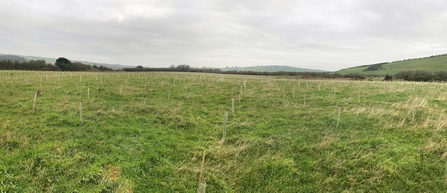The initial aim for this area of land was to convert it to wildflower grassland with a mix of winter seed producing plants for farmland birds. However, over the past few years of management, costs have increased for resowing and ploughing, and the increased incidence of ragwort within the soil has created problems for native wildflowers. Some ragwort is good yet not a crop!
Although the wildflower meadow project didn’t fully succeed, it has increased the abundance and variety of wildflowers nonetheless, and these will continue despite the tree planting. Over time they may be out shaded by the trees but will no doubt still remain as a ground cover in many places, providing pollinators and other insects with a food source.
The trees planted are of mixed species and include oak, birch, hazel, crab apple, willow, alder and rowan. These were planted by HW Forestry, a small local company in west Wales. The area has been fenced off from grazing but once the trees are established cattle will roam once again.
Planting trees in this area will also go some way in alleviating flooding further down the catchment by intercepting heavy rainfall. The interception of rainfall by trees can spread the effect of a rain storm over a longer time period. This allows some of the water (studies suggest up to 30%) to evaporate back into the atmosphere directly from the canopy without ever reaching the ground. All trees act in this way, but our native broadleaf trees do it best in summer when they’re in full leaf, but even in winter trees can intercept and re-evaporate rainfall.

